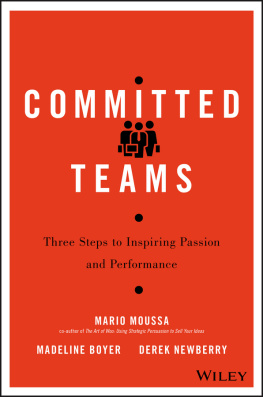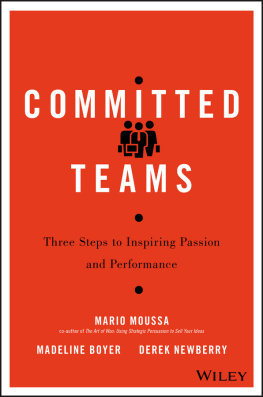Fourth Edition
Group
Dynamics
forTEAMS
Fourth Edition
Group
Dynamics
forTEAMS
Daniel Levi
California Polytechnic State University, San Luis Obispo


Los Angeles | London | New Delhi | Singapore | Washington DC
FOR INFORMATION:
SAGE Publications, Inc.
2455 Teller Road
Thousand Oaks, California 91320
E-mail:
SAGE Publications Ltd.
1 Olivers Yard
55 City Road
London, EC1Y 1SP
United Kingdom
SAGE Publications India Pvt. Ltd.
B 1/I 1 Mohan Cooperative Industrial Area
Mathura Road, New Delhi 110 044
India
SAGE Publications Asia-Pacific Pte. Ltd.
3 Church Street
#10-04 Samsung Hub
Singapore 049483
Acquisitions Editor: Reid Hester
Editorial Assistant: Sarita Sarak
Production Editor: Brittany Bauhaus
Copy Editor: Kimberly Hill
Typesetter: Hurix Systems
Pvt Ltd Proofreader: Dennis W. Webb
Indexer: Diggs Publication Services, Inc.
Cover Designer: Candice Harman
Marketing Manager: Lisa Sheldon Brown
Permissions Editor: Karen Ehrmann
Copyright 2014 by SAGE Publications, Inc.
All rights reserved. No part of this book may be reproduced or utilized in any form or by any means, electronic or mechanical, including photocopying, recording, or by any information storage and retrieval system, without permission in writing from the publisher.
Image Credits:
Thinkstock: 1, 39, 123, 261
iStock: Leading Virtual Teams icon
Printed in the United States of America
Library of Congress Cataloging-in-Publication Data
Levi, Daniel, PhD
Group dynamics for teams / Daniel Levi.4th ed.
p. cm.
Includes bibliographical references and index.
ISBN 978-1-4129-9953-3 (pbk.)
1. Teams in the workplace. I. Title.
HD66.L468 2014
658.4022dc23
2012042913
This book is printed on acid-free paper.
13 14 15 16 17 10 9 8 7 6 5 4 3 2 1
Brief Contents
Detailed Contents
Acknowledgments
Many people helped shape this book. My understanding of work teams, including both manufacturing and professional teams, was fostered by the many opportunities I have had to study and consult with actual teams in industry. Andrew Young, Margaret Lawn, and Don Devito created a number of opportunities for me to work with teams in the United States and abroad. Most of my research and consulting on work teams was performed with Charles Slem, my partner at Cal Poly, San Luis Obispo. In addition, I had the opportunity to work with engineering teams at Cal Poly as part of a NASA-supported program to improve engineering education. Daniel Mittleman, associate professor of Computing and Digital Media at DePaul University, helped me understand the impacts of virtual teamwork and contributed to the Leading Virtual Teams sections of the book. As a teacher of group dynamics, I learned by coteaching with Fred Stultz and Robert Christenson. The psychology, business, and engineering students in my group dynamics and teamwork classes have helped teach me about what is important about how teams operate.
The support of various editors at SAGE Publications has been invaluable. I have also benefited from the many anonymous academic reviews of the book and proposed revisions. In addition, Judith Barnes, Kathy Johnston, and Sara Kocher labored diligently to improve my language and make the text more readable. My wife, Sara, deserves special credit for her thoughtful reviews and supportive presence throughout this process.
For comprehensive reviews of the manuscript, I would like to thank the following reviewers:
Russell O. Mays, Georgia Southern University
Mark A. Arvisais, Towson University
Anita Leffel, The University of Texas at San Antonio
Kevin L. Nadal, John Jay College of Criminal Justice
Kerrie Q. Baker, Cedar Crest College
C. Kevin Synnott, Eastern Connecticut State University
Introduction
T here are two sources of information about teamwork. First, there is a large body of research in psychology and the social sciences called group dynamics that examines how people work in small groups. This research has been collected over the past century and has developed into a broad base of knowledge about the operation of groups. Second, the use of teams in the workplace has expanded rapidly during the past three decades. Management researchers and applied social scientists have studied this development to provide advice to organizations about how to make teams operate more effectively. However, these two areas of research and knowledge often operate along separate paths.
The purpose of this book is to unite these two important perspectives on how people work together. It organizes research and theories of group dynamics so this information can be applied to the ways in which teams operate in organizations. The concepts of group dynamics are presented so they are useful for people who work in teams and enlarge their understandings of how teams operate. It is hoped that this integration will help readers better understand the internal dynamics of teams so they can become more effective team leaders and members.
The larger goal of this book is to make teams more successful. Teams and groups are important in our society, and learning teamwork skills is important for individual career success. This book presents many concepts related to how groups and teams operate. In addition, the chapters contain application sections with techniques, advice for leading virtual teams, case studies (called Team Leaders Challenge), surveys, and activities that are designed to develop teamwork skills. The appendix contains tools and advice to help students in project teams. Teamwork is not just something one reads about and then understands: Teamwork develops through guided experience and feedback. This book provides a framework for teaching about teams and improving how teams function.
Overview
The seventeen chapters in this book cover a wide range of topics related to group dynamics and teamwork. These chapters are organized into four parts: characteristics of teams, processes of teamwork, issues teams face, and organizational context of teams. An appendix provides advice and tools to support student project teams.
Part I: Characteristics of Teams
explains the differences between groups and teams. This chapter also examines the purpose of using teams in organizations and why they are increasing in use. It concludes with a brief history of both the use of teams and the study of group dynamics.
explores the characteristics of successful teams. It explains the basic components that are necessary to create effective teams and examines the characteristics of successful work teams. In many ways, this chapter establishes a goal for team members, whereas the rest of the book explains how to reach that goal.
Part II: Processes of Teamwork
examines the processes that relate to forming teams. Team members must be socialized or incorporated into teams. Teams must establish goals and norms (operating rules) to begin work. These are the first steps in team development.
presents some of the main concepts from group dynamics that explain how teams operate. Working together as groups affects the motivation of participants both positively and negatively. Team members form social relationships with one another that help define their identities as teams. Teams divide their tasks into different roles to coordinate their work. The actions of team members can be viewed as either task oriented or social, both of which are necessary for teams to function smoothly. Teams are dynamic entities that adapt to changes and learn how to work together more effectively.
Next page










